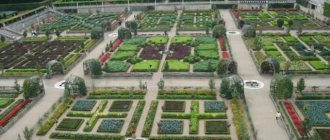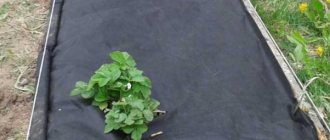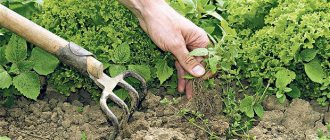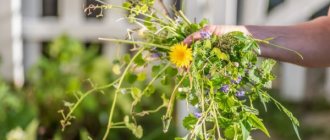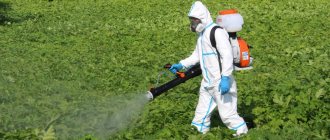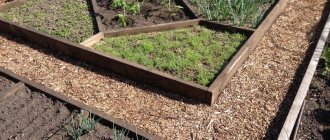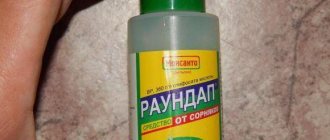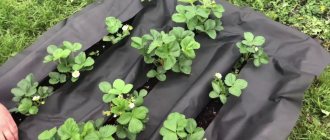Advantages and disadvantages of using geotextiles
Due to its advantages, this material is increasingly used in landscape design. It is light and compact, durable and economical, easy to install, can pass water and retain soil, inhibits the germination of weeds, maintains uniform soil temperature as a result of heat exchange, is chemically neutral and resistant to mechanical action.
Among the disadvantages are instability to direct exposure to UV radiation and additional expenses for its purchase when arranging the territory.
Density of geotextiles for weed control
Very often the question arises about what density of geotextiles is needed to control weeds. It was already said above that the normal indicator is a level of 16–50 g/m2. The high density of geotextiles for weed protection can cause a lack of oxygen and moisture for the growth of crops.
Most often, needle-punched geotextiles are laid. The use of geotextiles produced by this method allows achieving excellent results due to its permeability. In addition, you can buy geotextiles against weeds to protect the root system from the cold - thanks to the porous, uneven structure, needle-punched material will be an ideal option. It is worth remembering that the use of geotextiles produced by woven method is not allowed due to its excessively high density and low throughput. Therefore, for use in a garden plot, it is worth buying geotextiles produced specifically for these purposes - for example, agrofibre.
Characteristics of geotextiles
Geotextiles have many properties, which allows them to perform various functions.
The main characteristics of this material should be highlighted:
- permeates moisture well;
- does not rot;
- retains its properties for about 15 years;
- used in temperature conditions -60°С–60°С;
- can hold soft soils on slopes;
- prevents weeds and plant roots from germinating.
The use of road geotextiles on your site
Since this material is actively used in road construction, a popular area is the use of geotextiles for garden paths. The canvases allow you to separate layers to reduce the level of load on the base of the structure. Also, such raw materials are an excellent solution if it is necessary to reinforce the soil, which is especially important when moisture levels are high.
When arranging garden paths, you can profitably use another property of the canvas - to prevent pressing of crushed stone, thereby guaranteeing a higher level of compaction. In addition, thanks to the use of raw materials, it will be possible to achieve the following results:
- reduce the cost of purchasing sand or crushed stone;
- reduce the time required for the construction process;
- reduce the cost of further maintenance of a parking lot or garden path.
Agrofibres are also actively used for the formation of open areas around the house and the formation of rocky gardens. Thanks to this material, it will be possible to create beautiful patio areas, divide and build various types of embankments, and strengthen surfaces. It is impossible to imagine the creation of children's playgrounds in suburban areas without the use of agrofibre.
Types of geotextiles for landscape design
According to its composition, geotextile is divided into:
- polypropylene - a durable material that allows moisture to pass through well and does not rot;
- polyester - the material is more environmentally friendly, but has less strength;
- multi-component - made from recycled materials, costs less, but lasts less.
Important! Geotextiles, which are used for growing plants, are called agrofibre. It comes in two types: white - for covering plants, and black
-
to cover the ground.
This fabric can also be classified according to its production method.
It is divided into woven and non-woven. Woven geotextiles are produced by weaving threads. It has high strength, so it is mainly used in construction. With a low strength coefficient, woven geotextiles are used in territory design.
It can be used to strengthen a slope in a dacha and form an area for a garden bed. It is not suitable for drainage and filtration. Non-woven geotextiles have become more widespread in the design of territories and growing plants. It is worth considering its types in more detail.
Did you know? Geotextiles began to be produced in the USA and France in the 60s.
Needle-punched geotextiles
One type of material is created using the needle-punched method. It is non-woven and consists of polyester materials. Its purpose is to protect plants on the site from weeds, ultraviolet radiation, frost and strong winds. To do this, textiles are placed in the ground or spread on top of plants, depending on the purpose being pursued.
In territory design, this type of material is used to create rock gardens, under sidewalk paths, in the construction of artificial reservoirs, sports grounds and football fields. It finds its application when it is necessary to separate layers of materials, to protect walls and foundations from moisture, to cover the drainage layer, to reinforce the shore and slopes.
Did you know? The use of geotextiles in road construction reduces construction costs by 30-40% by reducing the thickness of the crushed stone layer.
Thermally bonded geotextiles
This non-woven type of material is obtained by thermal bonding of fibers. For this, only polypropylene threads are used. It has great strength. But its disadvantage is that it allows water to pass through only in the transverse direction. Due to its high strength, it is often used to strengthen the soil.
Protection of artificial reservoirs
Today, most outdoor pools and artificial ponds are created using polyvinyl chloride film. It is placed in a reservoir bowl, the bottom of which is covered with a layer of gravel and sand. The covering pillow holds its shape and external pressure well. But the film is easily torn by the stems of germinating plants and the sharp edges of stones that stick out during seasonal soil movements.
There is only one way to solve this problem - by laying thermally bonded geotextiles.
To permanently protect polyvinyl chloride film from external factors, the canvas must be laid in 2 layers:
- The first one is laid directly on the compacted soil of the reservoir bowl. Serving as a reinforcing level, it will protect the film from any plants, be it grass or a sprouting tree.
- The second one is placed on top of the covering pillow. It will protect the polyvinyl chloride from sharp stones and random weeds that get into the covering pad.
In addition to strengthening the bowl, tufted fabric is used to fix the shape of the shore of a pond or the edge of a pool. Sand is poured on top of the canvas, stones are laid or flowerpots with flowers are placed. A good solution is to lay natural or artificial grass lawn.
Which geotextiles are best used in landscape design
It is better to use needle-punched geotextiles in landscape design. Thanks to its high filtering capacity, it becomes suitable for any soil, even clayey ones. On slopes, reinforcing geogrid can be used to enhance its strength.
Pay attention to the use of decorative crushed stone in landscape design.
It is made from the same materials using similar technology. The main characteristics of geogrid are strength, non-toxicity, neutrality when exposed to chemical components, and resistance to UV rays. It is used to prevent the washing away of fertile soil and to combat erosion on slopes.
- Geotextile used in garden design will help solve the following problems:
- arrange lawns and protect flower beds from weeds;
- preserve fertile soil;
- strengthen the soil on slopes;
- protect plants from the adverse effects of nature.
This incredible material has a density of 50 g/m² and opens up new possibilities in the cultivation of flower beds and beds.
Agrofibre will help to effectively control weeds and get a strawberry crop with clean berries. In this case, the plant roots will receive the necessary moisture, which can be retained under the fabric. Agrofibre is used to completely cover the bed with it. The holes are cut with a knife, making them in a perpendicular direction. Seedlings are planted in the holes. In this case, the pores of the material are not clogged, and the fruits are not contaminated with soil.
Video: How to choose geotextiles
Features of geofabric
Due to the fact that garden geotextiles are made from needle-punched material using polyester and polypropylene threads using a non-woven method, they have many advantages.
Among which are:
- resistance to fungus and mold;
- no rotting;
- resistance to alkaline environments;
- high reliability indicators;
- does not cause interest in various rodents;
- excellent performance characteristics.
Types of geomaterial differ in density level. If the use of geotextiles in the country is required, this figure ranges from 80 to 200 g/m².
How to use geotextiles correctly
Geotextiles have the ability to separate layers of materials or soils with different fertility, preventing them from mixing, can serve as a filter and are widely used in drainage work, protect against weeds and tree roots, strengthen slopes and prevent erosion. Depending on the functions that the material has, various types of it are used for landscaping.
Important! When covering beds with agrofibre, this should be done with an overlap of 25 cm.
Garden path improvements
To arrange paths in the garden you need:
- Determine the exact boundaries of the path and stretch the fishing line along the edge.
- Dig a ditch within these boundaries with a depth of 35–40 cm;
- Cover the even surface of the ditch with geotextile with a density of 150–200 g/m² so that on both sides the edge rises 5–8 cm above the soil.
- Pour crushed stone to a thickness of about 15 cm.
- Spread a second layer of textile.
- Cover the surface with fine sand 10–12 cm thick.
- After compaction, paving slabs should be laid.
At the end of the work, the protruding edges of the geotextile must be cut off, and the gaps between the tiles must be filled with sand. Such a path has many advantages compared to one in the construction of which geotextile was not used.
Crushed stone serves as a drainage base for the path, and thanks to the non-woven material, it does not mix with the ground. Sand also does not mix with crushed stone and serves as a cushion for the tiles. All materials are well compacted. If a small area subsides, you can easily correct the situation by pouring sand under the raised tile. In addition, the material protects the path from weed germination, which is not unimportant.
Did you know? From geotextiles you can construct an African bed on top that resembles a keyhole. In the center of it there is a compost basket, by watering which the garden bed receives nutrients.
Waterproofing of reservoirs
When creating an artificial reservoir on a site, the main component of this structure is a waterproofing membrane. It is laid on the surface of the reservoir bowl so that the water does not leave it. To protect the membrane from damage, it is necessary to lay geotextiles with a density of 250 g/m² on the ground. It would not be superfluous to cover the waterproofing material with another protective layer of textile.
Arrangement of the territory at home
The versatility of geotextiles is that it can be used to create any structures in the country. When restraining sloping soils, creating open playgrounds and sloping forms, rocky gardens, patios, one cannot do without its use. The material is successfully used for lining under a layer of turf when creating lawns.
Pay attention to the information about the minimalist style in landscape design.
Construction of foundations and walls
To protect a concrete foundation from groundwater, thermally bonded material is used. It does not accumulate moisture, only allows it to pass out, separates the foundation from the ground, and protects from the destructive influence of the roots of nearby trees. The basic parameter for choosing a material is its density. For this type of work it should be 250 g/m².
A material with a lower density may not withstand the load and tear; a material with a higher density will cost more. Geotextiles are rolled out in a trench under the foundation along its entire length. The cut parts of the canvas are laid overlapping. The headroom must be higher than the level of the proposed foundation. The next layers of the house base are installed on top of the fabric.
For flower beds
Also, using agrofibre, you can separate the layer of soil and decorative mulch in flower beds. This will help fight weeds, retain moisture for plants and prevent the soil from mixing with the mulch layer.
Important! The pores in agrofibre not only allow moisture to pass through, but also provide the necessary air exchange. Loosening the soil is not required, since the soil is not compacted due to the capillary entry of moisture.
If the soil in the flower bed is not fertile, then the fiber can be used to plant plants in holes or ditches covered with it and covered with fertile soil. After this application, the fertile soil will not be eroded, which will increase the efficiency of plant growth.
Substrate for crushed stone
When building paths on a site made of pebbles or crushed stone, laying one layer of textile is sufficient. If you do not use this material, the coating will soon sink into the ground. As a result, the path will become covered with uneven surfaces and puddles. A wooden deck can be installed on top of such an embankment. It will look attractive in the garden design, and its service life will be much longer.
The use of modern material in the design of the territory is due to its versatility and high quality. The obstacle to the appearance of weeds and the ability to pass moisture in one direction is a great help in caring for plants and in landscaping work on a summer cottage. To achieve maximum effect, you should listen to the advice of experts and choose the right material for a certain type of work.
How is protection carried out?
It depends on where exactly you need to eliminate weeds. If we are talking about decorative landscapes, for example, paths, then the procedure is as follows:
- In the spring, at the time of increased growth of weeds, cut them down to the ground level (the roots can be left).
- Geotextiles are laid on top.
- Bulk material is laid on it (crushed stone and sand for paths, black soil or turf for lawns).
- Due to the physical blocking of space for weed growth, as well as due to its resistance to the tearing action of roots, geotextiles will not allow excess vegetation to break through the decorative bulk material.
If you need to eliminate weeds in the garden, then the procedure is slightly different:
- After planting cultivated plants, the area is covered with geotextiles.
- Holes are made in cultural planting areas to free up space for growth.
- The rest of the area remains a continuous cover through which weeds cannot grow.
You can also use a two-level technique:
- Trim weeds;
- Cover with thick geotextile;
- Pour fertile soil;
- Plant cultivated plants;
- Cover with a less dense type of material and make holes in the planting areas.

